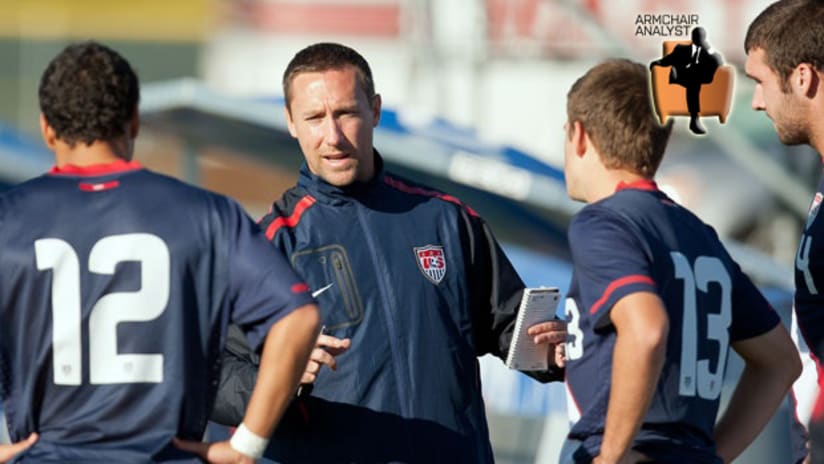Lucas Biglia and Rasmus Elm come together at midfield, a scene played out repeatedly in AZ Alkmaar’s 1-0 win over Anderlecht in Thursday’s Europa League clash.
Elm, as is his knack, wins the 50-50 ball, holds off Biglia and looks for all the world as if he’s going to play square and short to Maarten Martens. It is the right play, the low-risk play, the expected play.
But Elm, without even picking his head up, launches a 40-yard switch to a streaking Roy Beerens down the right wing, and AZ are off to the races. Beerens, a pacy, tricky winger, goes directly at Olivier Deschacht, turning the Belgian one way, then the other, then back again. They’re at the edge of the box now, and Charlison Benschop is diving toward the near post, dragging the Anderlecht central defense with him.
Klinsmann talks tactics on USsoccer.com
Deschacht, half on his backside now, makes a desperate lunge and – to the relief of the traveling fans – gets a toe to the ball, sending it out for a corner.
Threat over. For the moment.
Minutes later, though, the same situation plays out down the other flank. Again. And again. And again. It was 1-0, but it could have been 4-0 or 5-0 as easily.
Anderlecht spent Thursday afternoon chasing shadows, ending on the wrong side of a lesson from one of the world’s great practitioners of the 4-3-3.
Earlier that afternoon, on the other side of the world, the US Under-23 roster for the upcoming friendly against Mexico was announced, and it included four out-and-out wingers as well as several others who could, potentially, fill that role.
It did not, however, include Rasmus Elm. Nor did it include Roy Beerens. And that is an issue.
The 4-3-3 was a Brazilian invention of the early 1960s, designed mostly to give some defensive structure to a team built around Garrincha’s anarchic talent both on and off the ball. Pelé may be the greatest player in the history of the game, but in Brazil, it is the Little Bird who is the most beloved, who defined an era and to whom all great wingers must be compared.
What made Garrincha special (and Beerens, though magnitudes less so) was his ability, time after time, to beat the man in front of him with the ball on his foot and make a telling play. Or, should you decide to crowd him and deny him room to receive a pass, he’d simply turn into space and run past you, getting onto the end of one of those 40-yard passes, delivered, in his time, by Didi (the Xavi of his day) or Nito (the Busquets).
Caleb Porter’s US roster is meant to play the game the way AZ played it Thursday, and – in everyone’s wildest dreams – the way that Brazil played it 50 years ago.
But there is no Garrincha, no Beerens on this squad, wingers to beat the opposing fullbacks into submission. There is no Elm or Didi, central midfielders who excel at spreading the field and placing a first-time ball into space rather than at feet.
And while there is institutional desire in US soccer to adapt and become a 4-3-3 country in the Dutch mold, few of the players on the squad have been drilled in the finer points of the formation’s tactics either as youths or pros. Of the players on the roster, only Teal Bunbury plays in the 4-3-3 regularly for his club team.
Brek Shea is wonderful in the open field, but lacks the one-vs.-one ability so necessary for wingers in the system. He failed to beat his man with the ball on his foot a single time against Panama last month, and the scouting report was out on him in MLS by mid-August: Don’t let him receive the ball at pace, and he won’t hurt you.
Freddy Adu, meanwhile, lacks the pace and instincts to threaten teams off the ball on the flank. Joe Gyau could potentially be the answer, but he remains a head-down dribbler at this stage of his development.
In the midfield, I am a great fan of Dilly Duka, but switching the point of attack directly into a winger’s run is not one of his strong suits. Same for Mix Diskerud, who’s better at small combination play.
Michael Stephens and Jared Jeffrey, meanwhile, have both shown facility for connecting passes, but – again – not first time, and not into space.
The 4-3-3 is a thing of beauty when it works, which is why neutral fans tend to adore the teams that employ it well. But it takes time, discipline, repetition, instincts and distinct skill sets to make it happen.
Right now, I don’t see those skills on the US team, either Porter’s U-23s, or Klinsmann’s full national side. In switching to the 4-3-3 at this juncture, the US is trying to jump straight to calculus without first having mastered algebra.
Expect some real, severe growing pains along the way. Olympic qualifying starts next month, and that’ll be the first test of this new American orthodoxy. If they don’t get high marks, they'll be stuck watching how the 4-3-3 really functions every time they see the masters work it.
On television.














